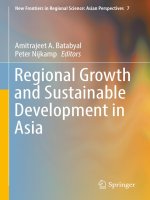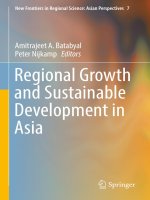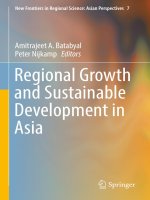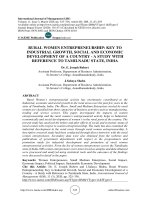Economic growth and economic development 175
Bạn đang xem bản rút gọn của tài liệu. Xem và tải ngay bản đầy đủ của tài liệu tại đây (93.49 KB, 1 trang )
Introduction to Modern Economic Growth
progress can gather speed (see, for example, Chapter 23). Alternatively, some natural (steady) progress of technology that may have been going on in the background
needs to reach a critical threshold for the process of growth to begin. These stories are quite plausible. World population has indeed increased tremendously over
the past one million years and the world’s inhabitants today have access to a pool
of knowledge and technology unimaginable to our ancestors. Could these long-run
developments of the world economy also account for cross-country differences? Is
the increase in world population a good explanation for the take off of the world
economy?
Let us focus on population to give a preliminary answer to these questions. The
simplest way of thinking of the relationship between population and technological
change is the Simon-Kremer model (after the demographer Julian Simon and the
economist Michael Kremer). This model is implicitly one of the entire world economy, since there are no cross-country differences and proponents of this model do
not try to explain differences across countries by their populations. Imagine that
there is a small probability that each individual will discover a new idea that will
contribute to the knowledge pool of the society. Crucially, these random discoveries are independent across individuals, so that a larger pool of individuals implies
discovery of more new ideas, increasing aggregate productivity. Let output be determined simply by technology (this can be generalized so that technology and capital
determine output as in the Solow model, but this does not affect the point we would
like to make here):
Y (t) = A (t) L (t)α Z 1−α ,
where α ∈ (0, 1), Y (t) is world output, A (t) is the world stock of technology, L (t)
is world population, and Z is some other fixed factor of production, for example,
land, which we normalized to Z = 1 without loss of any generality. Imagine we are
in a continuous time world and suppose that
(4.1)
A˙ (t) = λL (t) ,
where λ represents the rate at which random individuals make discoveries improving
the knowledge pool of the society, and the initial level of world knowledge A (0) > 0
is taken as given. Population, in turn, is a function of output, for example because
161









